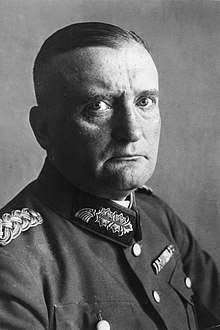This article may require cleanup to meet Wikipedia's quality standards. The specific problem is: More sources are needed. (March 2017) |
Kurt Freiherr von Hammerstein-Equord | |
|---|---|
 General Freiherr von Hammerstein-Equord in 1930 | |
| 4th Chief of the German Army Command Weimar Republic | |
| In office 1 November 1930 – 31 January 1934 | |
| President | Paul von Hindenburg |
| Preceded by | Wilhelm Heye |
| Succeeded by | Werner von Fritsch |
| 6th Chief of the Troop Office | |
| In office 30 September 1929 – 31 October 1930 | |
| Preceded by | Werner von Blomberg |
| Succeeded by | Wilhelm Adam |
| Personal details | |
| Born | 26 September 1878 Hinrichshagen, Grand Duchy of Mecklenburg-Strelitz, German Empire |
| Died | 24 April 1943 (aged 64) Berlin, Prussia, Nazi Germany |
| Relations |
|
| Known for | German resistance to Nazism |
| Military service | |
| Allegiance | |
| Branch/service | |
| Years of service | 1898–1934 1939 |
| Rank | Generaloberst |
| Battles/wars | World War I |
Kurt Gebhard Adolf Philipp Freiherr von Hammerstein-Equord[1] (26 September 1878 – 24 April 1943) was a German general (Generaloberst) who was the Commander-in-Chief of the Reichswehr, the Weimar Republic's armed forces. He is regarded as "an undisguised opponent" of Adolf Hitler and the Nazi regime.[2][3]
- ^ Regarding personal names: Freiherr is a former title (translated as 'Baron'). In Germany since 1919, it forms part of family names. The feminine forms are Freifrau and Freiin.
- ^ Kirsch, Adam (2010-06-10). "Can We Judge General von Hammerstein?". New York Review of Books. ISSN 0028-7504. Archived from the original on 2020-08-17. Retrieved 2020-09-02.
- ^ Cite error: The named reference
:1was invoked but never defined (see the help page).